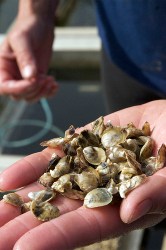
Jon_RowleyYoung oysters, aka “oyster seeds,” are increasingly vulnerable as the ocean absorbs carbon and becomes more acidic.
Terry Sawyer is on a mission to rescue oysters from newly hostile seas. Sawyer has been farming these briny bivalves for almost 30 years in Tomales Bay, north of San Francisco, at Hog Island Oyster Company. The business he co-owns sells $9 million worth of Sweetwaters, Kumamotos, and Atlantic oysters a year at the company’s two local oyster bars, at nearby farmers markets, and direct from the farm to hungry consumers who can’t seem to get enough of this sustainable shellfish. But Sawyer’s seafood business is threatened by ocean acidification (aka climate change’s evil twin) and he and other oyster growers are working overtime to find creative ways to save these sea creatures — and their own livelihoods.
As the ocean absorbs carbon dioxide from the air like a sponge, it also grows increasingly acidic. As a result, baby bivalves, or “oyster seeds,” have a tougher time growing shells and maturing into those plump, juicy adults destined for dinner plates. (Acidification, which lowers the pH of salt water, has also recently been shown to make for a hostile environment for other marine life, such as sea snails.) This shift in the chemical makeup of seawater started wreaking havoc in Washington a few years ago, when Taylor Shellfish Farms and Whiskey Creek Shellfish Hatchery began losing large numbers of oyster larvae.
But the Pacific Northwest wasn’t alone in this predicament: California’s oyster industry has long relied on hatcheries in Oregon and Washington for its oyster seeds. “We’re getting squeezed,” Sawyer told a group at a recent tour of his farm. “While demand is growing, seed sources are dying off. We’re talking about a paradigm shift.”
In previous years, Sawyer said he bought some 7 million oyster seeds from hatcheries. (There’s a significant mortality rate from seed to market; on average only 50 percent survive in the 18 months to three years it takes for an oyster to mature.) This year, he could buy just 2.5 million seeds — supplies are down as a result of this problem — and they were much smaller than the typical six-millimeter size he used to purchase, which significantly lowers the oysters’ chances of survival.
So, out of necessity, Sawyer finds himself in the oyster seed growing business. And he’s solicited help to keep his baby bivalves alive. Hog Island has partnered with scientists at UC Davis’s Bodega Marine Laboratory to keep close tabs on these vulnerable young oysters in the same waters where they used to thrive without much fuss. Such collaboration between scientists and shellfish industry innovators to study, and, ideally, minimize the damage caused by ocean acidification has already taken place at Whiskey Creek with scientists from Oregon State University and will likely be replicated all along the western coastline, said Tessa Hill, lead scientist on the Hog Island partnership.
Hill and her colleagues place sensors in the cold Tomales Bay waters to measure temperature, salinity, and pH levels. So Sawyer can now check conditions around the oysters on an hourly basis. For the past three months the scientists have been maintaining the sensors and interpreting data they’ve collected. Sawyer has shared the findings with other oyster farmers in the area in the spirit of collaborating for the common good. “There is definitely a culture of openness about trying to solve this problem,” said Hill, who added that while it’s early in their monitoring process, Hog Island can use information already gleaned from the data to, for example, change the water flow into their oyster tanks, if needed, to avoid low pH levels.
Such research can’t happen fast enough, as this industry-wide dilemma unfolds. In fact, just this week, Washington State Gov. Christine Gregoire (D) signed an executive order mandating that her state address ocean acidification on the same day an expert panel she convened announced its recommendations to protect the state’s $270 million shellfish industry. Gregoire also allocated $3.3 million towards efforts to combat the problem (like reducing carbon dioxide emissions), and recommended funding for a new university research center to study the issue.
The bottom line for now? “The oyster industry is in jeopardy,” said restaurateur Jesse Ziff Cool, who attended last month’s Hog Island tour and reported back to her staff on what’s happening in nearby waters. Cool says she wants to hold an awareness dinner to educate diners about the risks faced by their much-loved local oysters. And she wants to school them on another emerging reality about the popular shellfish, too. “The cost of oysters might skyrocket in the next few years.”
Outrageous prices and shortages aside, saving the shellfish industry is going to take a multi-pronged approach like the one getting started at Hog Island. But that might be the least humans can do as fossil-fuel pollution threatens a key filter feeder that cleans gallons of seawater a day, allowing other marine life to survive and thrive.
Despite the ominous outlook for oysters, oyster growers like Sawyer remain optimistic — and have recent innovation on their side. “The only reason we still have oyster farmers on the West Coast is because they were extraordinarily lucky, smart, and resourceful,” said Brad Warren of the nonprofit Sustainable Fisheries Partnership, and a member of Washington’s Blue Ribbon Panel on Ocean Acidification. “They teamed up with scientists, figured out what was killing their tiny baby oysters … and worked out ways to dodge or treat the corrosive water that was causing the problem,” he added. “The oyster industry survived the blow and, for now, they are adapting. These people are the coal mine canaries who lived to sing.”




